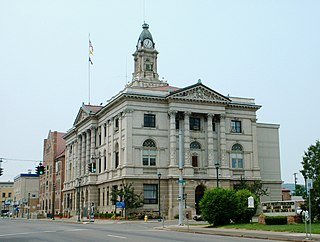
Elmira is the largest city and the county seat of Chemung County, New York, United States. It is the principal city of the Elmira, New York, metropolitan statistical area, which encompasses Chemung County, New York. The population was 29,200 at the 2010 census.

William Still was an African-American abolitionist based in Philadelphia, Pennsylvania. He was a conductor on the Underground Railroad, businessman, writer, historian and civil rights activist. Before the American Civil War, Still was chairman of the Vigilance Committee of the Pennsylvania Anti-Slavery Society. He directly aided fugitive slaves and also kept records of the people served in order to help families reunite.
John Todd was a U.S. Congregationalist minister, co-founder of Tabor College in Tabor, Iowa, a leading abolitionist and a 'conductor' on the Underground Railroad.

Woodlawn Cemetery is the name of a cemetery in Elmira, New York, United States. Its most famous burials are Mark Twain and his wife Olivia Langdon Clemens. Many members of the United States Congress, including Jacob Sloat Fassett are also interred there.
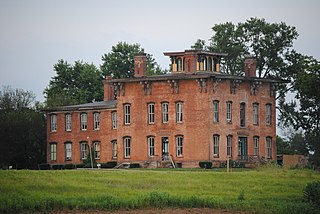
Prospect Place, also known as Trinway Mansion and Prospect Place Mansion, is a 29-room mansion built by abolitionist George Willison Adams in Trinway, Ohio, just north of Dresden in 1856. Today, it is the home of the non-profit G. W. Adams Educational Center, Inc. The mansion is listed on the National Register of Historic Places and the Ohio Underground Railroad Association's list of Underground Railroad sites.

Woodlawn National Cemetery is a United States National Cemetery within Woodlawn Cemetery, which is in the city of Elmira, in Chemung County, New York. Administered by the United States Department of Veterans Affairs, it encompasses 10.5 acres (4.2 ha), and as of 2021, had over 11,000 interred remains.

John W. Jones, was born on a plantation in Leesburg, Virginia, he was enslaved by the Ellzey family. Jones is buried in Woodlawn National Cemetery, not far from Mark Twain. He was married to Rachel Jones in 1856, with whom he had three sons and one daughter. On June 3, 1844, fearing he would be sold to another plantation, as his enslaver grew old and near death, Jones and four others fled north. They survived a 300-mile trip and arrived in Elmira, New York in July 1844. In Elmira, Jones was an active agent in the Underground Railroad.

Woodlawn is a historic house located in Fairfax County, Virginia. Originally a part of Mount Vernon, George Washington's historic plantation estate, it was subdivided in the 19th century by abolitionists to demonstrate the viability of a free labor system. The address is now 9000 Richmond Highway, Alexandria, Virginia, but due to expansion of Fort Belvoir and reconstruction of historic Route 1, access is via Woodlawn Road slightly south of Jeff Todd Way/State Route 235. The house is a designated National Historic Landmark, primarily for its association with the Washington family, but also for the role it played in the historic preservation movement. It is now a museum property owned and managed by the National Trust for Historic Preservation.

Camp Moore, north of the Village of Tangipahoa near Kentwood, Louisiana, was a Confederate training base and principal base of operations in eastern Louisiana and southwestern Mississippi. The base was named for Louisiana Governor Thomas Overton Moore. It operated from May 1861 to 1864 during the American Civil War. Confederate monuments were erected at the cemetery and on the grounds in the early 20th century.

The Owen Lovejoy House is a historic house museum on East Peru Street in Princeton, Illinois. Built in 1838, it was for many years home to Owen Lovejoy (1811-1864), a prominent abolitionist and congressman. Lovejoy was an open operator of shelter and support on the Underground Railroad, and his house contains a concealed compartment in which escaped slaves could be hidden. It was declared a National Historic Landmark in 1997. It is open seasonally or by appointment for tours.
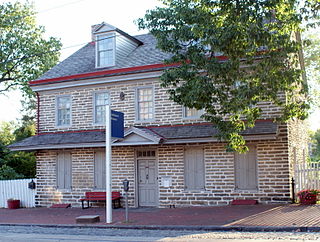
The John Johnson House is a National Historic Landmark in the Germantown section of Philadelphia, significant for its role in the antislavery movement and the Underground Railroad. It is located at 6306 Germantown Avenue and is a contributing property of the Colonial Germantown Historic District, which is also a National Historic Landmark. It is operated today as a museum open to the public.

Rokeby Museum is a historic farm property and museum at 4334 United States Route 7 in Ferrisburgh, Vermont. The 90-acre (36 ha) property includes a 1780s farmstead, and eight agricultural outbuildings with permanent exhibits. Hiking trails cover more than 50 acres (20 ha) of the grounds. Rokeby is open from mid-May to mid-October each year. The property was designated a National Historic Landmark in 1997 for its association with Rowland T. Robinson, a Quaker and ardent abolitionist who openly sheltered escaped slaves at Rokeby as part of the Underground Railroad. Robinson's extensive correspondence is an essential archive giving insight into the practices of abolitionists and the operations of the railroad.

The John P. Parker House is a historic house museum at 300 North Front Street in Ripley, Ohio. It was home to former slave and inventor John P. Parker (1827–1900) from 1853 to his death in 1900. Parker was an abolitionist and a well-documented conductor on the Underground Railroad, helping hundreds of escaped slaves. The house was listed on the National Register of Historic Places in 1980, and it was further designated a National Historic Landmark in 1997. It is now owned and managed by a local nonprofit organization as a museum about Parker's life and the abolitionist movement.

The John Rankin House is a historic house museum at 6152 Rankin Hill Road in Ripley, Ohio. Built in 1828, it was home to Presbyterian abolitionist John Rankin, and was one of the original stops on the Underground Railroad. Harriet Beecher Stowe's visit to Rankin provided some of the story that became Uncle Tom's Cabin. The house was acquired by the State of Ohio in 1938 and is now operated by the Ohio History Connection and opened for tours. It was designated a National Historic Landmark in 1997.
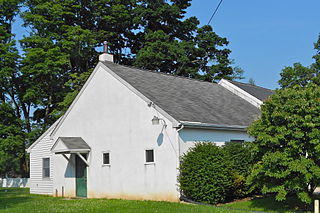
Ercildoun, population about 100, is an unincorporated community in East Fallowfield Township, Chester County, Pennsylvania, United States. The hamlet was founded by Quakers and was an early center of the abolitionist movement. In 1985 the entire hamlet, including 31 properties, was listed as a historic district on the National Register of Historic Places. Of these properties two were vacant land, 14 were significant buildings, ten were contributing buildings, and five buildings, built in the 1950s, were non-contributing. The Lukens Pierce House, an octagon house listed separately on the U.S. National Register of Historic Places, is located about half a mile northwest of the hamlet. Ercildoun is one of about ten hamlets in the township, which has no cities or towns, but has 31 sites listed on the National Register. It is one of the larger hamlets, located near the center of the township, and historically among the best known. The city of Coatesville is about 3 miles north.
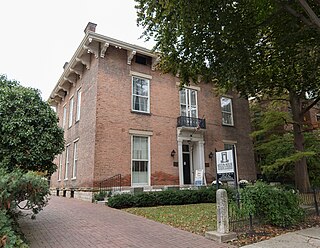
The Kelton House Museum and Garden is a Greek Revival and Italianate mansion in the Discovery District of downtown Columbus, Ohio. The museum was established by the Junior League of Columbus to promote an understanding of daily life, customs, and decorative arts in 19th-century Columbus and to educate visitors about the Underground Railroad.

The Chemung County Historical Society is headquartered in the historic Chemung Canal Bank Building in Elmira, New York. It is dedicated to the collection, preservation, and presentation of the history of the Chemung River Valley region. The society was founded in 1923 and first chartered by New York State in 1947. It is accredited by the American Alliance of Museums, and currently operates two cultural repositories, the Chemung Valley History Museum and the Booth Library, both as non-profit educational institutions.

Pierce & Bickford was an American architect partnership of Joseph H. Pierce and H. H. Bickford, based in Elmira, New York, that was active during 1890–1930.

Simeon Benjamin was a businessman, philanthropist, and founder of Elmira College.

























